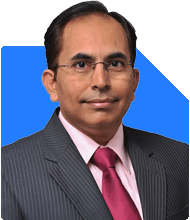Ramalingam Kalirajan |9863 Answers |Ask -Follow
Mutual Funds, Financial Planning Expert - Answered on Jun 04, 2024
He has an MBA in finance from the University of Madras and is a certified financial planner.
He is the director and chief financial planner at Holistic Investment, a Chennai-based firm that offers financial planning and wealth management advice.... more

I will be retiring in nov ,24. I have pf of rs 22000000, leave encashment rs 3100000, gratuity rs2500000,fd 2200000,nps rs 5000000, ppf rs 1500000. I have no liability except daughter's marriage 5-6 years from now, have own house. Need a monthly income of rs 175000. G Ganguly.
Assessing Your Financial Situation
Monthly Income Requirement
Your monthly income requirement is Rs 1,75,000. This translates to an annual requirement of Rs 21,00,000. Considering your accumulated wealth, we will aim to generate this income while preserving and growing your corpus.
Daughter's Marriage
Your daughter’s marriage is anticipated in 5-6 years. We will allocate funds to ensure this goal is met without affecting your monthly income.
Evaluating Current Assets
Provident Fund (PF)
Your PF corpus of Rs 2.2 crores is substantial. PF is typically a low-risk investment providing stable returns, suitable for meeting regular expenses.
Leave Encashment
The leave encashment amount of Rs 31 lakhs provides additional liquidity, which can be utilized for immediate financial needs or invested for future growth.
Gratuity
Gratuity of Rs 25 lakhs is another lump sum that can be strategically invested to generate returns.
Fixed Deposits (FD)
Your FD corpus of Rs 22 lakhs offers security and guaranteed returns. However, the returns might not be sufficient to meet inflation-adjusted expenses.
National Pension System (NPS)
NPS corpus of Rs 50 lakhs is a good long-term investment with tax benefits. It can be partially withdrawn and the rest converted into an annuity.
Public Provident Fund (PPF)
PPF amounting to Rs 15 lakhs is tax-free and offers decent returns. It can be used as a safe investment for long-term growth.
Generating Monthly Income
To generate a monthly income of Rs 1,75,000, a diversified investment strategy is essential. This strategy will balance between security and growth, ensuring a steady income stream and preservation of capital.
Systematic Withdrawal Plan (SWP)
A Systematic Withdrawal Plan (SWP) in mutual funds can be an effective way to generate regular income. By investing a portion of your corpus in a balanced or debt-oriented mutual fund, you can set up monthly withdrawals. SWPs offer flexibility and potential for capital appreciation.
Mutual Funds
Investing in mutual funds will provide diversification and professional management. Actively managed mutual funds can yield better returns than index funds. A certified financial planner (CFP) can help select the right mix of equity and debt funds to balance risk and return.
Actively Managed Funds vs. Index Funds
Actively managed funds have professional managers aiming to outperform the market. Despite higher fees, they often yield better long-term returns. Index funds, on the other hand, replicate market indices and offer average returns. For your goals, actively managed funds are more suitable.
Regular Funds vs. Direct Funds
Investing through regular funds involves a commission for mutual fund distributors (MFDs). The expertise of a CFP ensures better fund selection and management. Direct funds save on commission but lack professional oversight. Regular funds offer better-managed investments, making them a wise choice.
Debt Mutual Funds
Debt mutual funds provide stability and regular income with lower risk. These funds are suitable for medium-term goals and act as a buffer against market volatility. A portion of your corpus can be allocated to debt funds for stability.
Ensuring Adequate Insurance
Life Insurance
Ensure you have adequate life insurance coverage to protect your family’s financial future. Avoid investment-cum-insurance policies like ULIPs, LIC endowment plans, as they offer lower returns and inadequate insurance cover. Consider surrendering such policies and reinvesting the proceeds in mutual funds.
Health Insurance
Adequate health insurance is crucial in retirement. Review your existing health coverage and consider increasing it if necessary. Medical expenses can be substantial, and comprehensive health insurance will protect your savings.
Emergency Fund
Maintain an emergency fund equivalent to 6-12 months of expenses. This fund should be easily accessible and kept in a high-interest savings account or liquid mutual fund. An emergency fund provides financial security against unforeseen expenses.
Allocating Funds for Daughter's Marriage
Your daughter’s marriage is a significant financial goal. Estimate the expenses and allocate a portion of your corpus to safe and secure investments. Fixed deposits, debt funds, or balanced funds can be suitable for this purpose. Ensure these investments align with the 5-6 year time frame.
Portfolio Diversification
Diversifying your portfolio is crucial to manage risk and enhance returns. A balanced mix of equity, debt, and other asset classes will provide stability and growth. Regular reviews and rebalancing ensure the portfolio remains aligned with your goals.
Equity Investments
Equity investments offer high growth potential. A portion of your corpus should be allocated to equity mutual funds. These funds can generate inflation-beating returns over the long term, ensuring your corpus grows.
Gold
Gold is a traditional and reliable investment, acting as a hedge against inflation and economic uncertainty. Consider investing in gold through sovereign gold bonds or gold ETFs. These options offer better returns and safety compared to physical gold.
Tax Planning
Efficient tax planning maximizes your disposable income. Utilize available deductions under Section 80C, 80D, and others. Your contributions to NPS, PPF, and mutual funds (ELSS) help in tax savings while building your corpus.
Regular Review and Adjustment
Regularly review your portfolio’s performance. Market conditions and personal goals change over time. Rebalance your investments to maintain the desired asset allocation. A CFP can provide valuable insights and adjustments.
Financial Discipline and Continuous Learning
Maintaining financial discipline is key to achieving your goals. Automate your investments to ensure consistency. Stay informed about financial markets and new investment opportunities. Financial literacy empowers better decision-making.
Professional Guidance
A CFP provides personalized advice aligned with your goals. Their expertise in financial planning ensures optimal investment strategies, tax efficiency, and risk management. Regular consultations help in adapting to changing circumstances and market conditions.
Conclusion
Your substantial corpus is a result of disciplined savings and prudent investments. To ensure a secure retirement and meet your financial goals, a diversified investment strategy is essential. Focus on generating regular income, maintaining adequate insurance, and planning for significant expenses like your daughter’s marriage.
Invest wisely, stay disciplined, and enjoy a secure financial future.
Best Regards,
K. Ramalingam, MBA, CFP,
Chief Financial Planner,
www.holisticinvestment.in
You may like to see similar questions and answers below
Ramalingam Kalirajan |9863 Answers |Ask -Follow
Mutual Funds, Financial Planning Expert - Answered on Jul 27, 2024
Ramalingam Kalirajan |9863 Answers |Ask -Follow
Mutual Funds, Financial Planning Expert - Answered on Jul 18, 2024
Janak Patel |62 Answers |Ask -Follow
MF, PF Expert - Answered on Jan 29, 2025
Ramalingam Kalirajan |9863 Answers |Ask -Follow
Mutual Funds, Financial Planning Expert - Answered on Feb 04, 2025
Ramalingam Kalirajan |9863 Answers |Ask -Follow
Mutual Funds, Financial Planning Expert - Answered on Feb 04, 2025
Ramalingam Kalirajan |9863 Answers |Ask -Follow
Mutual Funds, Financial Planning Expert - Answered on Jan 27, 2025
Dr Karan Gupta |160 Answers |Ask -Follow
International Education Counsellor - Answered on Jul 28, 2025
Dr Karan Gupta |160 Answers |Ask -Follow
International Education Counsellor - Answered on Jul 28, 2025
Dr Karan Gupta |160 Answers |Ask -Follow
International Education Counsellor - Answered on Jul 28, 2025
Dr Karan Gupta |160 Answers |Ask -Follow
International Education Counsellor - Answered on Jul 28, 2025
Dr Karan Gupta |160 Answers |Ask -Follow
International Education Counsellor - Answered on Jul 28, 2025
Dr Karan Gupta |160 Answers |Ask -Follow
International Education Counsellor - Answered on Jul 28, 2025
Dr Karan Gupta |160 Answers |Ask -Follow
International Education Counsellor - Answered on Jul 28, 2025
Dr Karan Gupta |160 Answers |Ask -Follow
International Education Counsellor - Answered on Jul 28, 2025
Dr Karan Gupta |160 Answers |Ask -Follow
International Education Counsellor - Answered on Jul 28, 2025
Nayagam P P |9540 Answers |Ask -Follow
Career Counsellor - Answered on Jul 28, 2025























